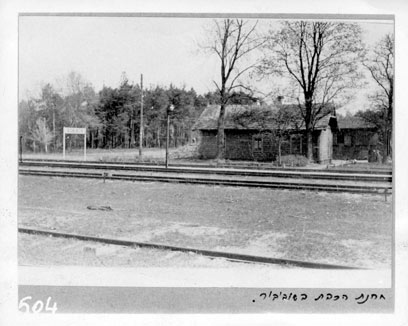
Wedding ring found outside Sobibor gas chamber
צילום: יורם חיימי
Archaeologists unearth Sobibor's gas chambers
Led by Yoram Haimi, international team discovers exact location of extermination camp's killing chambers, in breakthrough finding for project.
Yad Vashem announced this week that it discovered the exact location of the gas chambers at the Sobibor German Nazi extermination camp in occupied Poland, thanks to the tireless work of archaeologists at the site.
Yoram Haimi, one of the archaeologists, said "this is a tremendous achievement for me and my research team."
The archaeological dig at the Sobibor camp began in 2007 by Haimi, by the Israel Antiquities Authority, and his Polish partner, Vitek Mazurek; Dutch archaeologist Dr. Ivar Schute joined the project in 2013.
The dig has been supervised and supported by Yad Vashem's center for international research on the Holocaust, the German-Polish foundation, and the museum at Majdanek. Over the years, archaeologists have unearthed thousands of personal items: rings, lockets, earrings, jewelry, perfume bottles, medicine bottles, and utensils.
Dr. David Silberklang, a senior historian and editor at Yad Vashem Studies, said the new finding was important for Holocaust research. "The discovery of the exact location of the gas chambers is one of the most important finds in Shoah research."
He explained: "Not a single shard remained of the Jews who worked near the gas chambers, and thus these findings are all that is left of the murdered. Essentially, this is a small window into their daily suffering."
Dr. Silberklang stressed the importance of the latest discovery. "This is the first time that we can better understand the mechanism for murder at the camp, and what the Jews endured until their murder."
"Additionally, the exact size of the gas chambers will allow us to understand their capacity and then we can have a more accurate estimate of the number murdered in the camp. These findings complement what we have learned from the survivors who escaped the camp during the revolt," he added.
Haimi said that exposing the chambers was a significant success. "After almost eight years of digging at Sobibor this is a great achievement for me and the research team, we finally reached our goal – identifying the exact location of the gas chambers. We were surprised by the size of the structure and the condition of the chambers' walls."
Haimi, whose relatives were murdered in the camp, added: "The most emotional moment was when we found, near the gas chambers, a wedding ring inscribed with a Hebrew wedding vow."
This week the archaeologists also discovered the water well used by the prisoners in camp 1, where the revolt occurred. There were many Jewish personal items in the well, because after the camp was demolished, the Nazis filled the well with all that was left behind.
The Sobibor Nazi extermination camp was located by the village and train station of Sobibor, on the eastern outskirts of Lublin in Poland. It was established in April 1942 together with Treblinka and Belzec.
When the death camp was operational – from April 1942 to October 1943 – some 250,000 Jews were murdered within the compound.
After the prisoners' revolt on October 14, 1943, the Nazis decided to dismantle the camp, leaving it exposed without any of the noticeable signs of its murderous intent. Until now, researchers and archaeologists had been guided solely by survivors' testimonies.












